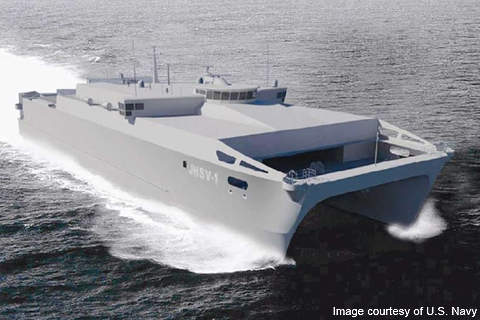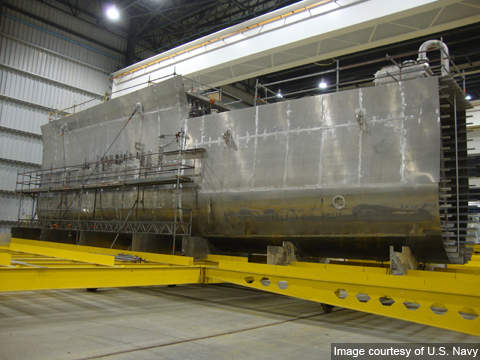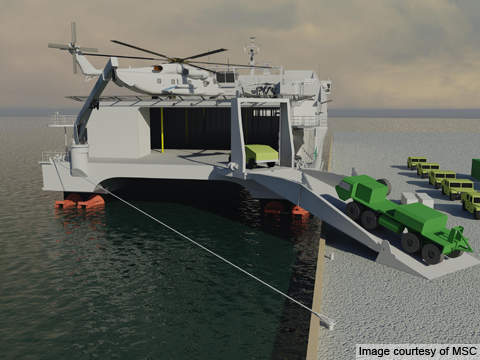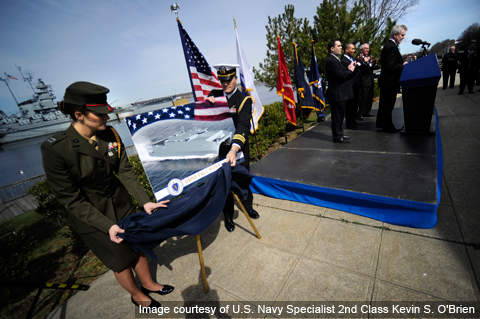Expeditionary Fast Transport (EPF) ships, previously known as Joint High Speed Vessels (JHSV), are being built by Austal USA as part of the EPF programme initiated by the US Navy.
Operated by the Military Sealift Command, the EPF vessels support joint or coalition force operations of the army and navy.
The main roles of the vessels are the transportation of troops, military vehicles, cargo and equipment for a range of global missions. They will also support military logistics and humanitarian relief operations.
Development and construction of the JHSV
The preliminary design contract for the EPF programme was awarded in February 2008. The programme initially called for five EPF vessels to be delivered to the army, as well as five to the Navy and Marine Corps.
In November 2008, the US Navy placed a $185.4m contract for the detailed design and construction of an EPF, with options for up to nine additional ships. The initial critical design review (ICDR) was completed by May 2009.
The first three vessels were named Spearhead T-EPF 1 (ex-JHSV 1), Vigilant (T-EPF 2) and Fortitude (T-EPF 3) in July 2009. Construction of Vigilant and Fortitude was authorised by the US Navy in January 2010.
The keel for the first ship in the class, USNS Spearhead (T-EPF-1), was laid at Austal’s shipyard at Mobile, Alabama, in July 2010. It was launched and christened as USNS Spearhead in September 2011. The ship successfully completed acceptance trials in September 2012 and was formally handed over to the US Navy in December 2012. The US Navy concluded initial operational testing and evaluation of T-EPF 1 in October 2013.
Construction of USNS Choctaw County (T-EPF-2) (ex-Vigilant) began in September 2010. In May 2011, the US Army transferred all five of its EPFs to the Navy. The T-EPF 2 was christened as USNS Choctaw County in September 2012 and launched in October 2012. The keel for the third EPF (now, Millinocket) was laid down in May 2012, and the vessel was launched in June 2013. Deliveries of the second and third EPFs took place in June 2013 and March 2014, respectively. The USNS Millinocket (T-EPF-3) participated in the Rim of the Pacific (RIMPAC) Exercise 2014.
The keel-laying of the fourth EPF, Fall River, was held in May 2013, and the ship was launched in January 2014. Acceptance trials were completed in July 2014, and the vessel was delivered to the US Navy in September 2014. The keel for the fifth ship in the class, USNS Trenton (T-EPF 5) (ex-JHSV 5), was laid in March 2014, and the vessel was launched in September 2014. It was delivered to the US Navy in April 2015.
The US Navy exercised contract options for the construction of the sixth and seventh ships in July 2011. Construction of the sixth vessel, named USNS Brunswick (T-EPF 6) (ex-JHSV 6), commenced in January 2014, and the keel was laid in December 2014. The vessel was launched in May 2015 and delivered in January 2016. Construction on the seventh EPF, named Carson City, began in September 2014.
The keel of USNS Carson City (T-EPF-7) was laid in July 2015. The ship was launched in January 2016 and delivered in June of the same year.
The contract options for the construction of eighth and ninth EPFs were exercised in February 2012. The US Navy exercised the $166.9m contract option for the final vessel of the ten-ship programme in December 2012.
The eighth EPF, USNS Yuma, was launched in September 2016 and delivered in April 2017. The keel for USNS Bismarck (T-EPF-9) was laid in January 2017, and the vessel was launched in June 2017.
Austal USA was awarded a $326m contract by the US Navy to construct EPF 11 and EPF 12 in September 2016.
Joint High Speed Vessel design features
The EPF features rounded bilge and bulbous bow hull forms made of aluminium. The catamaran vessel is built to American Bureau of Shipping (ABS) standards. On-board systems comply with the commercial ABS steel vessel regulations.
The ship does not feature combat systems or the ability to support or use LCS mission modules. EPF is based on commercial technology but includes limited military features, such as aviation, C4SI and fire-fighting.
The vessel has a length of 103m, beam of 28.5m and draft of 3.8m. The displacement of the ship is 2,362t.
The open unobstructed mission deck has a usable cargo area of more than 1,800m² with a clear height of 4.7m and turning diameter of 26.2m.
Performance and power of the US Navy ships
EPF can be operated in shallow-draft ports and waterways, interfacing with roll-on / roll-off discharge facilities and on / off-loading. The stern loading ramp can support an M1A2 Abrams main battle tank.
The ships can transport 635t of payload for more than 1,200nm at an average speed of 35k. EPF is manned by the civilian mariners provided by the Military Sealift Command. The vessel has a crew of approximately 42 people.
Aircraft capabilities of Austal USA’s JHSV
The EPF features a Navair level 1 class 2 certified flight deck to support the operations of one helicopter, such as a CH-53E Super Stallion.
The ship is equipped with a centreline parking area for one helicopter, vertical replenishment area and helicopter control station.
Kongsberg Maritime was contracted to supply the EPF’s helicopter operations surveillance system (HOSS).
Operated from the control room, the HOSS system allows helicopter operations in very low light conditions.
The system integrates a MIL-S-901D shock qualified 19in SXGA LCD monitor suitable for night vision device (NVD) operations.
JHSV propulsion and crew accommodation
EPF is powered by four MTU 20V8000 M71L diesel engines driving four Wartsila WLD 1400 SR waterjets with four ZF 60000NR2H reduction gears. Each engine rated at 9.1MW provides a maximum speed of 43k without payload. The propulsion system delivers superior fuel efficiency to reduce operating costs.
The ship provides accommodation for 42 crew members in two single staterooms, six double staterooms and seven four-bed staterooms. There is airline-style seating for more than 312 embarked forces, as well as permanent berths for approximately 104 personnel and temporary berths for 46 troops.











